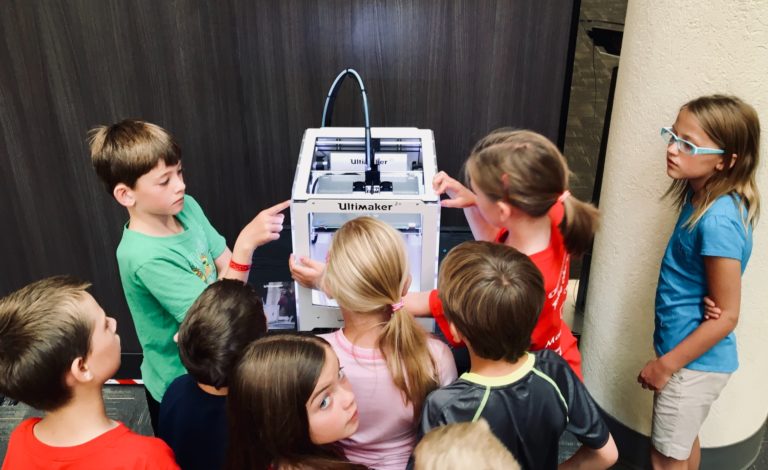The role of technology in today’s world is significantly different from what it used to be in the past. Nowadays, it has become a necessity in every office, household, and even school. Particularly for children, technology is integrated into the education system to enhance their cognitive abilities. However, many questions whether technology truly benefits our children or if it has negative effects on their eyes and minds.
This ongoing debate is prevalent in countless households, as the right answer remains elusive. On one hand, technology can assist in improving learning abilities, fostering engagement in educational activities, and igniting an interest in studying. On the other hand, excessive exposure to mobile phones and TVs can isolate children in their rooms and potentially impair their vision and mental capabilities.
Ultimately, the impact of technology depends on how we utilize it. The outcomes can vary depending on screen time and the purpose of usage. Let’s delve into the importance of technology and how it can genuinely benefit our little ones.

Importance of Technology in Early Childhood Education
Technology encompasses more than just songs, movies, cartoons, and entertainment. With scientific advancements, it plays a vital role in promoting the healthy development and effective education of our young learners. Unlike our own childhood experiences, today’s children have access to big projectors, 3D animations, and tablets that allow them to visualize and comprehend the text they read. Let’s explore how these resources can facilitate children during their formative years.
- Improvement in motor skills: Tablets offer games and activities specifically designed for preschoolers, engaging their hands in response to sounds. These enjoyable activities not only foster creative thinking but also enhance coordination.
- Development of social skills: Whether at school or at home, when children come together to complete an activity on a tablet, it encourages communication and better self-expression.
- Facilitates information processing: Visual aids and auditory tools help children grasp and retain information for longer periods. By utilizing these resources, we can effectively convey what we aim to teach.
- Makes learning interesting: From toddlers to older children, everyone is captivated by animations, animals, and pictures. Integrating these elements into education helps cultivate a greater interest in learning.
- Promotes basic academic skills: Through videos, images, and animations, children can quickly grasp fundamental concepts such as colors, shapes, and numbers.
- Broadens the horizons: Incorporating technology into education not only broadens the horizons of our little ones but also makes the learning process engaging and enjoyable.

Incorporating Technology in Early Childhood Education
Now that we understand the significance of technology in early childhood education, you may be wondering how to effectively integrate it into your children’s lifestyle in a positive manner. Well, worry not! We have the answer for you.
1. Utilizing Technology as a Learning Tool
Have you noticed how children, even toddlers, are always captivated by their phones and curious about your laptops? It can be worrisome to witness our kids obsessing over screens constantly. However, we can turn things around by utilizing technology as a tool for learning, rather than solely for entertainment. The internet offers a vast array of videos and apps that teach essential foundations such as the alphabet, numbers, words, shapes, and other fundamental concepts necessary for their educational journey. So, the next time they ask for your phone, hand it to them with an educational video. They’ll not only dance to the tunes but also absorb important terms and knowledge.
2. Increased Learning Opportunities for Children
Education today differs greatly from what it used to be. In the past, our learning resources were limited to textbooks, reference books from libraries, and a few online videos. However, modern technology presents our children with a multitude of platforms to learn, comprehend, and apply their newfound knowledge. This not only enhances their overall understanding but also sharpens their problem-solving skills. Moreover, teachers can engage in one-to-one sessions with their students, providing guidance, conducting discussions with parents, sharing information, and offering online activities related to specific subjects. In this way, every child gets a chance to learn, grow, and improve while having fun along the way.
3. Fosters Stronger Connections Among Families and Educators
Technology offers a valuable avenue to strengthen the bond between students, parents, and teachers. Online platforms provide a space for everyone to come together and discuss progress, interests, aspirations, and concerns regarding a child’s education. Even if you can’t physically attend your children’s school, you can simply hold a meeting on your mobile phone and stay informed about their activities. Through these collaborative efforts and regular communication with educators, parents can establish a solid educational foundation for their children, supporting them on the path to success.
4. Enhances Effectiveness through Adult and Peer Interaction
Education becomes more impactful when adults and peers actively engage with children. Remember when our parents used to sit with us and teach us math or point out the colors of the sky, grass, and benches during walks? Learning became effortless with their guidance and involvement.
Likewise, it is crucial for us to interact with our children, jointly plan activities, and encourage their participation in both academic and extracurricular endeavors. By managing content and screen time wisely, we can collaborate with them to help them grasp concepts and ensure better retention over time. Through this shared effort, we empower our children to learn, grow, and thrive.

Examples of the Role of Technology in Early Childhood Education
There are numerous ways to incorporate technology into your children’s lives while ensuring it has a positive impact on them. Just as everyone uses smartphones, computers, and laptops for entertainment, you can leverage these devices to create a successful learning environment for your children. Let’s explore some examples of how technology can serve as a powerful learning tool and provide them with valuable educational opportunities.
- When discussing unfamiliar concepts like bears, children may not know whether it’s an animal or something they can eat. In such cases, the internet’s vast collection of images and videos can help them explore and understand various animals, shapes, and figures.
- Technology can also be used to teach your children new words. Through shared reading experiences, you can engage them in books, discovering new expressions, phrases, and vocabulary together.
- Online platforms offer audio recordings of different poems, allowing children to learn the poems and improve their pronunciation as well.
- As parents, our schedules often become busier, leaving little time to meet other parents in person. However, technology enables us to schedule meetings and video calls to discuss mutual concerns about our children and make important decisions regarding their schooling.
- By combining photos, audio recordings, and creating documents, you can keep track of your child’s progress and development over time.
- Engaging in children’s games with them not only strengthens your bond but also opens the door for them to share their thoughts and secrets. This way, they will feel comfortable discussing everything with you and maintain a healthier mental state, keeping depression at bay.
- By leveraging technology thoughtfully, we can create a balanced and enriching experience for our children, fostering their growth, and building strong connections along the way.
Summary
Combining fun and education may seem like an impossible feat, but it’s not as challenging as it appears. While the incorporation of technology in a child’s early life remains a topic of controversy, it has undeniably become an integral part of our modern world. Therefore, reaching a well-informed decision is crucial.
When controlled and used appropriately, technology can have a positive impact on your child’s developmental stages. It has the potential to enhance their motor, emotional, and social skills, facilitating better and faster learning, and additionally, visualizing information through technology aids in the easier processing of knowledge, surpassing the limitations of mere reading.
Thus, the incorporation of technology can be beneficial as long as it is utilized as a learning tool, leveraging images, drawing assistants, and audio files. So, don’t hesitate to fulfill your children’s request for a tablet. With proper management, you can foster closeness with them and impart education while having fun through the use of technology.

Cecilia Yeung is a successful entrepreneur and product researcher. She has a background in psychology and children’s education. As a working mother of two, she loves to write about children’s education and development.



